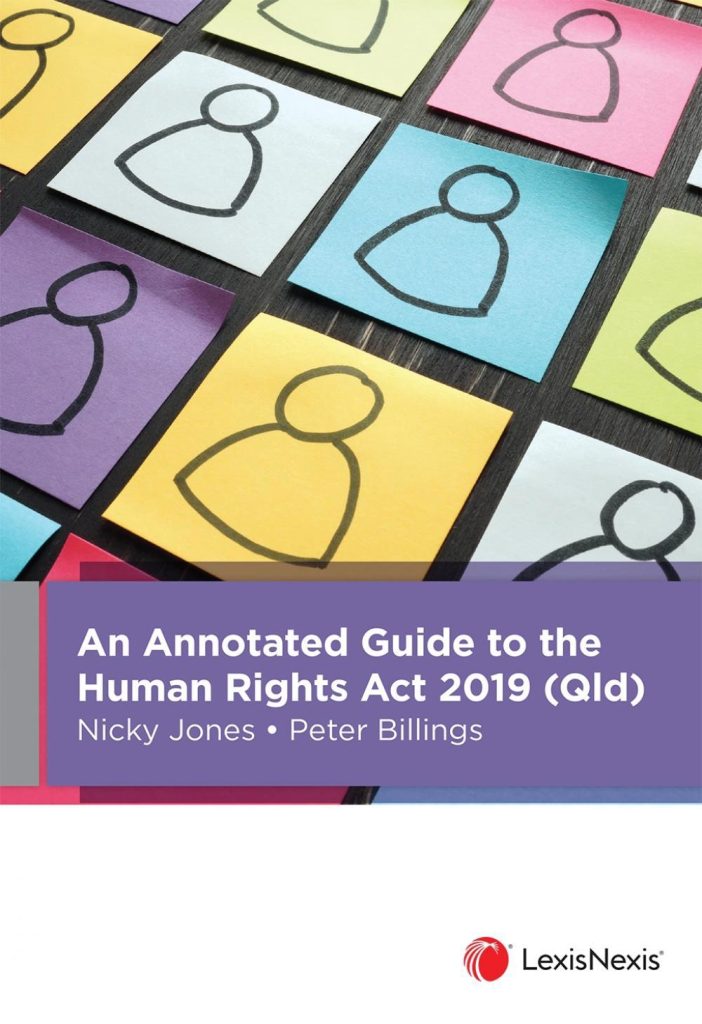Authors: Dr Nicky Jones & Professor Peter Billings
Publisher: LexisNexis
Reviewer: Samuel Lane
Dr Nicky Jones and Professor Peter Billings have put together an extremely comprehensive and thoughtfully drafted text for anyone who is required to look at the Human Rights Act 2019 (Qld) (“Human Rights Act” or the “Act”).
While the text appears to be primarily for legal practitioners, it is written in such an accessible way that it would be a very useful companion also for those outside the law. This is particularly important as any “public entity” must not now fail to give proper consideration to any human right relevant to their decisions. As the Honourable Michael Kirby AC CMG said, “I congratulate the authors of this text for writing this excellent and practical work to introduce judges, practising lawyers, civil society and ordinary citizens to the context of the Human Rights Act 2019 (Qld).”
Chapter 1 of the text provides the reader with an overview of the history and an explanation of the key events that brought us to the Human Rights Act in Queensland, as well as some important national context, by observing Commonwealth policy and parliamentary milestones. It commences by noting that, in 2018, when the Human Rights Bill was introduced to the Queensland Parliament, 70 years had passed since the United Nations General Assembly adopted the Universal Declaration of Human Rights. It is a useful introduction to the Human Rights Act.
An overview of the structure and application of the Human Rights Act is set out in Chapter 2. This is another important chapter in the text, as it sets up for the reader the rights protected by the Act, the manner in which they are protected and the interaction between “public entities” and the Human Rights Commission (which is, also, established under the Act). Useful introductory remarks to international human rights jurisprudence are made in this chapter, as well as an important explanation of the key differences between the Victorian Charter of Human Rights and Responsibilities 2006 (Vic) and the Act. Chapter 2 is an excellent introduction to the following Chapters 3 to 5, which provide the annotated commentary to each and every section of the Human Rights Act.
Chapter 3 of the text provides detailed commentary on the Preamble and Part 1 of the Act. That is, the preliminary provisions of the Act. This is an extremely detailed chapter, which gives due importance to the introductory provisions of the Act, concerning the scope, purpose and objects of the Act. It also carefully considers (in the case of ss6 – 10 of the Act) the interpretative provisions of the Act, without which the essential terms for the operation of the Act would not be understood. There is a particularly detailed consideration of ss9 and 10 of the Act (the definition of “public entity” and when a function is of a public nature), which is unsurprising given the importance that those sections have in the overall application of the Act. As is customary with annotated textbooks, each section of the Act is first set out, followed by relevant and detailed commentary.
Chapter 4 then catalogues the substantive human rights (and who has those human rights) contained in ss11 to 37 of the Act. This chapter is comprehensive and very carefully researched. It provides up-to-date case law references to decisions from the Queensland courts, including Owen-D’Arcy v Chief Executive, Queensland Corrective Services [2021] QSC 273, which is perhaps the most significant case to date involving a consideration of various provisions of the Act and how they may be “piggy-backed” on to a judicial review application. In addition to the emerging Queensland jurisprudence, the authors draw on significant works from international and inter-state courts and tribunals to assist the reader with understanding the Human Rights Act and to provide authoritative commentary on each section. Helpfully, in respect of all sections of the Act, the authors conclude their commentary by giving the reader an understanding of other provisions of the Act that are related. This is particularly useful to public entities who are required to consider the human rights affected by their decision making.
Part 3 of the Act is set out and discussed in detail in Chapter 5. The text considers the application of the Human Rights Act in Queensland and how the various divisions of Part 3 set out the roles and responsibilities of each branch of government in the application of the human rights protected by the Act. Of particular relevance to practitioners is the discussion of s 58 (Conduct of Public Entities) and s 59 (Legal Proceedings), which, together, provide the manner in which proceedings might come to “piggy-back” a human rights complaint (where there is “unlawfulness” in an act or decision of a public entity) on to another cause of action.
Chapter 6 deals with the expansion of powers and the function of the Human Rights Commission. This chapter sets out in detail the unique function of the Human Rights Commission and the processes that might be invoked through it, noting that such processes are intended to provide more practical and meaningful outcomes for participants.
As a final note, Appendix 2 to the text provides a very useful table setting out comparable human rights provisions from other jurisdictions, both international and inter-state. This is particularly useful to practitioners where there is limited jurisprudence in Queensland on particular provisions of the Act in that it facilitates the identification of jurisprudence with respect to similar rights from other jurisdictions which may aid in interpreting the Queensland rights.
An Annotated Guide to the Human Rights Act 2019 (Qld) is a very helpful tool for practitioners, government agencies and civil society more broadly. It has been carefully researched and prepared, and is drafted to make it maximally accessible to all readers. It is a most worthwhile addition to any practitioner’s library.



